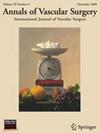与血管内介入治疗相比,急性肠系膜缺血的开放性血管重建术会增加发病率和死亡率。
IF 1.4
4区 医学
Q3 PERIPHERAL VASCULAR DISEASE
引用次数: 0
摘要
目的:从历史上看,由于可能切除肠道,开放式方法一直被认为是治疗急性肠系膜缺血(AMI)的主要方法。然而,血管内治疗的使用正在增加。鉴于目前的数据很少,本研究旨在比较急性肠系膜缺血开放式和血管内介入治疗的结果:方法:根据 ICD-9 和 ICD-10 编码,在国家外科质量改进计划(NSQIP)中对 2011 年至 2022 年间接受 AMI 治疗的患者进行识别。介入类型(开放式与血管内介入)来自 CPT 代码。对不同介入类型的人口统计学、合并症、术前实验室值和 30 天预后进行了比较。采用多变量分析来调整组间差异,并将患者是否需要切除肠道纳入考虑疾病严重程度的因素:共有1172名患者因急性心肌梗死接受了血管再通手术(1023人接受了开放性手术,149人接受了血管内手术)。在接受开放性血管重建术的患者中,577 人(56%)接受了血栓切除术/肠切除术,125 人(12%)接受了血栓内膜切除术,321 人(31%)接受了搭桥术。在接受血管内再通术的患者中,101 人(68%)接受了支架植入术,23 人(15%)接受了血管成形术而未植入支架,25 人(17%)接受了溶栓/血栓切除术。接受血管内血运重建的患者吸烟率较高(36%为开放手术,47%为血管内手术;P结论:考虑到切除肠道的需要和合并症,与血管内介入治疗相比,开放性急性心肌梗死血管重建术的围手术期发病率和死亡率更高。因此,不应该因为需要切除肠道而排除血管内治疗急性心肌梗死。本文章由计算机程序翻译,如有差异,请以英文原文为准。
Open Revascularization for Acute Mesenteric Ischemia is Associated with Increased Morbidity and Mortality when Compared to Endovascular Intervention
Objectives
Historically, open approaches have been considered the primary treatment for acute mesenteric ischemia (AMI) due to the potential for bowel resection. However, the use of endovascular therapy is increasing. Given the paucity of current data, this study aims to compare outcomes between open and endovascular interventions for AMI.
Methods
Patients treated for AMI between 2011 and 2022 were identified in the National Surgical Quality Improvement Program (NSQIP) by ICD-9 and ICD-10 codes. Intervention type (open vs. endovascular) was obtained from CPT codes. Demographics, comorbidities, pre-operative laboratory values, and 30-day outcomes were compared between intervention types. Multivariable analysis was utilized to adjust for differences between groups with a patient's need for bowel resection included to account for disease severity.
Results
A total of 1,172 patients underwent revascularization for AMI (1,023 open, 149 endovascular). Among those treated with open revascularization, 577 (56%) underwent thrombectomies/embolectomy, 125 (12%) underwent thromboendarterectomy, and 321 (31%) received bypasses. Of the patients who underwent endovascular revascularizations, 101 (68%) received a stent, 23 (15%) underwent angioplasty without stenting, and 25 (17%) underwent lysis/thrombectomy. Patients who underwent endovascular revascularization had higher rates of smoking (36% open vs. 47% endovascular; P < 0.01), were more likely to have an eGFR less than 30 (6% open vs. 15% endovascular; P < 0.01), and underwent more bowel resections at the time of the initial operation (33% open vs. 48% endovascular; P < 0.01). For outcomes, patients who underwent open repair had longer median hospital stays (10 days vs. 7 days; P < 0.01). All other outcomes including 30-day mortality were similar on univariate analysis. Following adjustment for the need for bowel resection and comorbidities, 30-day-mortality (OR 1.96, 95% CI: 1.28–3.02), failure to wean from ventilator (OR 1.56 95% CI: 1.05–2.34), and length of hospital stay (β 3.7 days, 95% CI: 1.8–5.6) were higher among patients treated with open surgery.
Conclusions
After accounting for the need for bowel resection and comorbidities, open revascularization for AMI is associated with higher peri-operative morbidity and mortality compared to endovascular intervention. Thus, the need for bowel resection should not preclude endovascular treatment for AMI.
求助全文
通过发布文献求助,成功后即可免费获取论文全文。
去求助
来源期刊
CiteScore
3.00
自引率
13.30%
发文量
603
审稿时长
50 days
期刊介绍:
Annals of Vascular Surgery, published eight times a year, invites original manuscripts reporting clinical and experimental work in vascular surgery for peer review. Articles may be submitted for the following sections of the journal:
Clinical Research (reports of clinical series, new drug or medical device trials)
Basic Science Research (new investigations, experimental work)
Case Reports (reports on a limited series of patients)
General Reviews (scholarly review of the existing literature on a relevant topic)
Developments in Endovascular and Endoscopic Surgery
Selected Techniques (technical maneuvers)
Historical Notes (interesting vignettes from the early days of vascular surgery)
Editorials/Correspondence

 求助内容:
求助内容: 应助结果提醒方式:
应助结果提醒方式:


